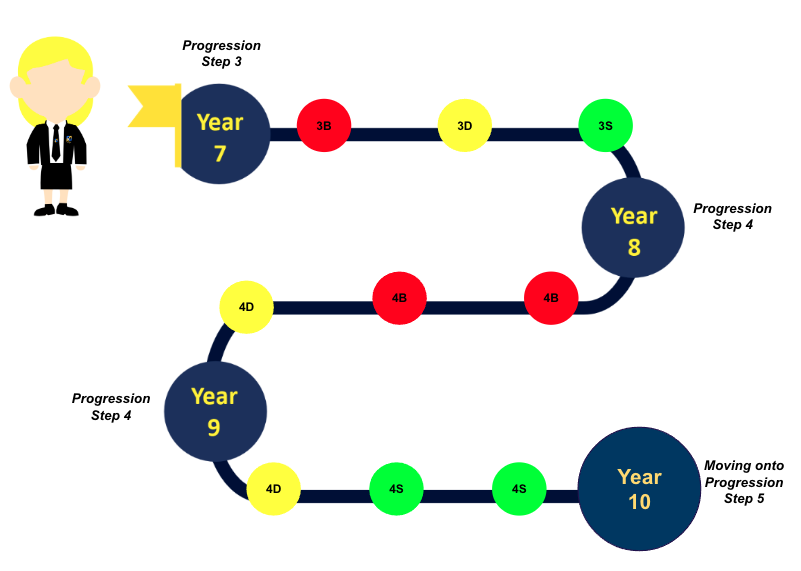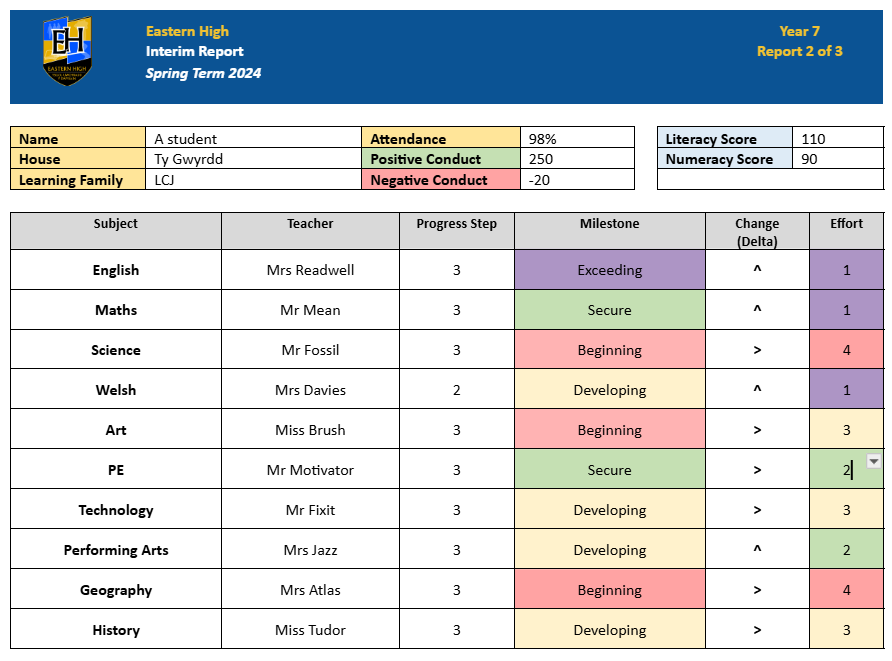Assessment Reporting
Understanding School Reports
At Eastern High, we issue three reports across the school year to keep you informed about your child’s academic progress and overall experience in school. These reports include a range of assessment and engagement data to help you track their development.
You will receive:
-
Two interim reports – These provide a snapshot of current progress using the latest assessment data. While interim reports do not include written comments, they offer a clear overview of your child’s progress from their starting point and are used to monitor pupil performance as well as the quality of teaching and learning.
-
One final academic report (issued in the summer term) – This report provides more comprehensive information and includes teacher comments explaining what your child has achieved over the year, outlining their strengths and identifying areas for improvement.
Each report will include:
-
Progress data for each subject
-
Effort grades, showing your child’s attitude to learning
-
Attendance figures
-
Behaviour and achievement points
-
Results of any formal assessments they have completed
It is important that you familiarise yourself with the progress measures used in our reports, as these help you to understand how your child is developing and how you can best support them at home in partnership with the school.
We also invite parents and carers to attend Parents’ Evenings and Meet the Tutor events, where you can discuss your child’s wellbeing, progress, and school life with their Learning Family Tutor, who will stay in regular contact throughout the year.
Below is a breakdown of what each report includes at different key stages to help you understand the information provided.
Understanding Progress Steps at Eastern High
At Eastern High, we use progress steps to track how your child is developing across the curriculum. These steps help us understand what your child knows, what they can do, and how well they are learning over time.
What Are Progress Steps?
The Welsh Curriculum is built around progression, not levels or grades. Instead, pupils move through Progress Steps, which describe the kinds of skills and knowledge they are developing.
Here's a simple guide:
| Progress Step | Typical Age Range | What It Means |
|---|---|---|
| Progress Step 2 | Ages 5–8 | Usually covered in primary school. Some pupils may still be working at this level in Year 7 if they need extra support. |
| Progress Step 3 | Ages 8–11 | Most Year 7 pupils will start here. They work to become secure in this step before moving on. |
| Progress Step 4 | Ages 11–14 | Most pupils work at this level during Years 8 and 9. The aim is to be secure by the end of Year 9. |
| Progress Step 5 | Ages 14–16 | This step is followed in Years 10 and 11 and prepares pupils for their GCSEs. |
However, it’s important to remember that every child’s learning journey is different. The Curriculum for Wales recognises that pupils will progress at different speeds — not just compared to others, but also compared to their own past progress. Learning often involves pauses, bursts of progress, and moments to revisit and secure understanding.
What Do the Stages Mean?
Each progress step is broken down into four stages to show how secure your child’s learning is:
-
Beginning – Your child is starting to learn the skills and knowledge in this step.
-
Developing – They are gaining confidence and can apply some of what they’ve learned.
-
Secure – They can apply most of the skills and knowledge consistently.
-
Exceeding – They have fully mastered this step and may be starting to explore the next one.
What Progress Should My Child Make?
We measure progress three times a year through Progress Reviews (PR1, PR2, PR3). Here is an example of how progress might look like for most learners:
Year 7
-
PR1 – Progress Step 3: Beginning
-
PR2 – Progress Step 3: Developing
-
PR3 – Progress Step 3: Secure
Year 8
-
PR1 – Progress Step 4: Beginning
-
PR2 – Progress Step 4: Beginning
-
PR3 – Progress Step 4: Developing
Year 9
-
PR1 – Progress Step 4: Developing
-
PR2 – Progress Step 4: Secure
-
PR3 – Progress Step 4: Secure
Pupils may spend longer at each stage within a progress step before moving on to the next. This is completely normal and expected. Each stage (Beginning, Developing, Secure, Exceeding) involves building a broad and deep understanding of key skills and knowledge, and it takes time to secure this learning.
Progress is not about moving through the steps quickly — it’s about ensuring that pupils are confident and capable before taking the next step. Some learners may move faster in one subject than another, and that’s okay.
At Eastern High, we focus on helping every pupil make meaningful progress at the right pace for them.
Understanding Progress at Eastern High
The progress steps we use are a guide, not a fixed expectation. They show roughly where most children of a certain age might be, but every learner is different. For example, a Year 7 pupil working at Progress Step 2: Developing by the end of the year could still be making excellent progress — especially if:
-
Their change symbol shows improvement (↑)
-
Their effort score is strong
-
Their achievement points are high
-
Their behaviour points are low
-
Their attendance is consistent
To fully understand your child’s progress, it's important to look at all the information in the report — progress step, effort, change from the previous report, attendance, and engagement in school life. These pieces of information together give the most accurate picture of how well they’re doing.
We recommend keeping each report safely, so you can track progress across the year and over time.
If you ever have questions or would like to discuss anything in your child’s report, please don’t hesitate to contact their teacher or Learning Family Tutor. We’re always here to help.
How Can I Support My Child?
Supporting your child’s progress doesn’t mean needing to have all the answers — it’s about staying informed, encouraging effort, and working closely with the school. Here are some simple but effective ways you can help:
-
Talk to your child about their report
Ask them how they feel about their progress and what they’re proud of. Celebrate successes and discuss any areas they’d like to improve. -
Focus on effort, not just outcomes
High effort scores and positive change arrows (↑) are strong signs that your child is trying their best — and effort is one of the biggest indicators of future success. -
Keep track of progress over time
Hold on to each report so you can look back and see how far your child has come, not just where they are now. -
Promote good habits at home
Encourage regular routines for homework, reading, and revision. Make sure they get plenty of rest and a good start to the school day. -
Stay in touch with the school
If you have any concerns or questions about your child’s report, progress, or wellbeing, reach out to their Learning Family Tutor or subject teachers. We’re always happy to help. -
Support attendance and engagement
Good attendance, positive behaviour, and getting involved in school life (clubs, trips, events) all support learning and confidence.
Example Report

Pupil Progress Example – A Student
Year 7 | Spring Term Report (2 of 3)
Overall Performance:
'A Student' is showing steady progress across most subjects with evidence of improvement in key areas. The pupil is working within Progress Step 3, which is expected for Year 7, and has made positive progress (^) in most subjects since the previous report.
Strengths:
-
High attendance at 98% supports consistency in learning.
-
Strong conduct record with 250 positive behaviour points, though slightly offset by -20 negative points.
-
Excellent progress in English – working at Exceeding within Progress Step 3, with a positive change (↑) and outstanding effort (1).
-
Maths also shows strong progress, working securely at Progress Step 3, with positive change and high effort.
-
Welsh is improving, progressing within Progress Step 2 to Developing, which shows positive movement (^).
-
Effort scores are consistently strong, mostly between 1 and 2, indicating good engagement and attitude to learning.
Areas for Development:
-
Science, Art, Geography, and History are currently at the Beginning stage of Progress Step 3. While these are within the expected range for this point in Year 7, further progress towards Developing or Secure would be beneficial.
-
Science and Geography effort scores are at 4, suggesting some challenges in engagement or behaviour. This may be an area to monitor and support.
-
Numeracy score (90) is lower than Literacy (110), possibly indicating an area that could benefit from extra support or focus.
Key Observations:
-
All subjects show positive change (^) — there are no downward trends (v), which suggests the pupil is moving in the right direction.
-
All subjects showing no change (>) - the pupil may need more time to fully understand these concepts before moving on.
-
PE and Technology are at the Secure and Developing stages respectively, with solid effort and steady progress.
-
The pupil appears to be engaging well overall and has shown improvement across several areas since the last report.
Next Steps:
-
Continue building on the strong foundation in English and Maths.
-
Provide encouragement and support in Science and Geography to help improve both progress and effort.
-
Celebrate the overall improvement and strong effort – this is a solid report showing potential for further progress by the end of the year.
-
Keep tracking progress in the final report (PR3) to see if milestones move from Beginning to Developing or Secure.
